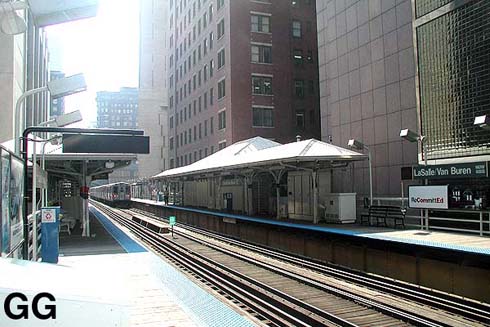
The LaSalle/Van Buren
station, looking east from the Inner Loop platform in July
2001. Except for new signs and lights and the AV
informational sign, the platforms look largely as they did
then the station opened 104 years before. For a larger view,
click here.
(Photo by Graham Garfield)
|
LaSalle/Van Buren
(140W/400S)
LaSalle Street and Van
Buren Street, Loop
Service
Notes:

|
Orange Line:
Midway
|

|
Brown Line:
Ravenswood
|

|
Purple Line:
Evanston Express
|

|
Pink Line:
54/Cermak-Loop
|

|
Transfer to
Metra: Rock Island District
|
Quick Facts:
Address: 121 W. Van Buren
Street
Established: October 3, 1897
Original Line: Name
Previous Names: Pacific Avenue
|
Skip-Stop Type:
|

|
Station
|
Rebuilt: n/a
Status: In Use
History:
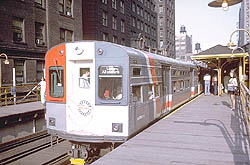
A pair of
Bicentennial 6000s are assigned to the Loop Shuttle, seen here at
LaSalle/Van Buren on July 7, 1975. Note that a "new
style" A/B symbol sign has already been installed
on the Outer Loop platform, seen across the tracks.
For a larger view, click here. (Photo by Doug Grotjahn,
Collection of Joe Testagrose) |
By the end of 1895, the only section of the Union Loop without a franchise was its southern leg. Levi Z. Leiter,
owner of much Loop property along Van Buren, strenuously
objected to this alignment. Uninterested in compromise,
Charles Tyson Yerkes created a new company, the Union
Consolidated Elevated Railroad with its purpose not only to
build the gap between Wabash and Wells, but also the
connection to the Metropolitan West Side Elevated. Unable to
sway the opinion of Leiter and his associates, Yerkes
announced that he'd build the Van Buren leg from Wabash to
Halsted Street, a distance of one mile. The western half of
this included mostly warehouses and industry who were at
best excited and at least indifferent to the presence of the
elevated. Their consent signatures coupled with those
already obtained east of Market Street were all Yerkes
needed to proceed. Of course, Yerkes never intended to
actually build the structure west of Market. Construction
east of Wells began in late 1896.
Like all other legs of the Loop, the Van Buren stations had
a uniform design, unique to their section. Although hardly
high-style architecture, its rectangular form, gable roof
with small dormers, smooth Tucson posts, fluted pilasters,
large double-hung windows, and unique ornamentation in the
pediment lend it to the Colonial Revival style. This
architectural style can not be found anywhere else on the
"L" and is unusual for its execution in sheet metal and tin.
This station and the Loop as a whole was activated October
3, 1897, first served by the Lake Street Elevated. The
Metropolitan followed in October 11, with the South Side
trailing on October 18.
The station was originally called Pacific Street station,
for its namesake street, whose named changed in the early
years of the 20th century.
LaSalle/Van Buren has a history of importance. An ad
published by the Metropolitan West Side Elevated urging
citizens to take the Met's trains to the south side White
City amusement park (despite the fact that Met trains went
no where near 63rd and South Park) instructed passengers to
change trains at LaSalle/Van Buren for the south side. What
they failed to tell them was that they had to pay a second
fare when transferring. An advertisement of the New York
Central Railroad urged customers to use the LaSalle/Van
Buren "L" station to reach their terminal at the nearby
LaSalle Street railroad station. The station is also a block
away from Chicago's financial district and is next to the
Board of Trade.
By 1942, as part of an ongoing platform lengthening
effort, the platforms of all three Van Buren stations had
been extended to the point of being continuous from State to
LaSalle. Trains still made separate stops along it, though.
Today, it is an independent station again.
The station has suffered relatively few serious
alterations. Still intact are the original station houses
complete with woodwork and pressed tin ceilings, the station
amenities like utility closets and fare collection booths
and the platform canopies. If restored like Quincy/Wells,
this station could provide another fine example of early "L" architecture.
At a press conference on Monday, June 5, 2000,
CTA President Frank
Kruesi announced that beginning Saturday, June 10th and
Sunday, June 11th, six downtown area 'L' and subway stations
and seven station entrances that were currently closed late
at night or on weekends would be open at all hours that
trains are in service. One of the stations that was a
Part-Time Station -- closed Sundays and Holidays -- was
LaSalle/Van Buren. Starting at 0700 hours Sunday, June 11th,
LaSalle/Van Buren returned to full-time operation. Opening
these stations and entrances is just one of the components
of a $539,000 service improvement package that was passed by
the Chicago Transit Board in May 2000.
LaSalle/Van Buren is the last of the original Van Buren
stations left. Dearborn/Van
Buren was closed in 1949 and State/Van
Buren was closed in 1973, both demolished in the
1970s. In 2016, LaSalle/Van Buren station made Preservation Chicago's 2016 "Most Endangered" list. The inner and outer Loop station houses are both included in the dubious honor.
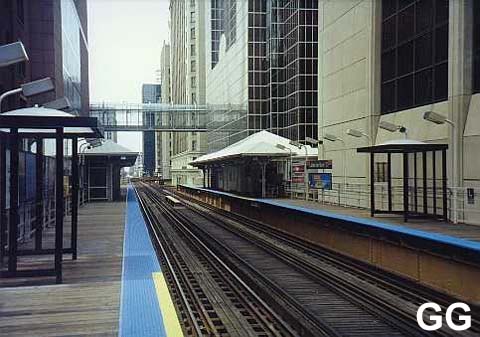
The LaSalle/Van Buren
station, looking west from the Outer Loop platform in 2000.
(Photo by Graham
Garfield)
|


|
lasalle-vanburen01.jpg
(28k)
An inbound North Shore Electric Line Silverliner
unloads a few passengers at LaSalle/Van Buren. Note the
transfer bridge (now gone) and old-style sign to the left of
the train. (Photo from the Racine County
Historical Society and Gerald Karwowski)
|

|
lasalle-vanburen04.jpg
(76k)
The trackside ticket windows are still in place
in both station houses, as seen here on the Inner Loop
station house in April 2002, though there are no longer
windows that the agent (now customer assistant) can talk
through. (Photo by Andrew
Stiffler)
|
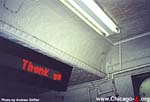
|
lasalle-vanburen05.jpg
(64k)
The interiors of the LaSalle/Van Buren station
houses have incredibly good historic integrity, still
retaining much of their original features such as the
pressed tin walls and ceiling seen at left in April 2002,
tongue-in-groove chair-rail wood paneling and oak doors and
moldings. (Photo by Andrew
Stiffler)
|
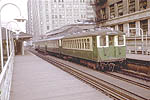
|
cta4273.jpg
(128k)
Car 4273 brings up the rear of a four-car Evanston Express
train as it approaches LaSalle/Van Buren on October 3,
1972. (Collection of Joe
Testagrose)
|

|
cta4283.jpg
(166k)
Car 4283 leads an Evanston Express at LaSalle/Van Buren on
October 3, 1973. The sign on the left directs transferring
passengers to the LaSalle Street commuter station to catch
Rock Island suburban trains.
(Collection of Joe
Testagrose)
|
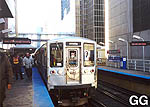
|
tour00k.jpg
(77k)
The 2200-series
2nd Annual Historic Station
Tour charter train stops at LaSalle/Van
Buren while the group walks around the Outer Loop
platform and hears a historical and architectural talk
inside the vintage station house. (Photo by
Graham Garfield)
|

|
lasalle-vanburen_SignInner.jpg
(69k)
A KDR-type
symbol sign from the LaSalle/Van Buren Inner Loop station,
with its blue background denoting its status as an AB or
All-Stop station. The KDR
symbol signs on the Loop were different in that they simply
spelled out the entire station name at the top rather than
using a large first letter of the station name (the
"symbol", so to speak) with the name below that. They also
denoted whether the station was on the Inner or Outer Loop.
With only Evanston services serving this platform when the
sign was made, the Inner Loop station was typically closed
except during rush hours. (Sign from the
Andrew Stiffler Collection)
|
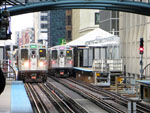 |
cta5122_5041.jpg (265k)
Two 5000-series trains pass on the Van Buren side of the Loop on October 18, 2013, as a Harlem-bound Green Line Looper led by car 5122 approaches Harold Washington Library-State/Van Buren station, leaving a Pink Line train trailed by car 5041 at LaSalle/Van Buren station. This is the last day that certain Green Line trains would circle the Outer Loop in the evening rush period -- the service pattern was a weekday-only variant during the Red Line South Reconstruction Project, and the project would be over two days later, Sunday, October 20. (Photo by Graham Garfield) |
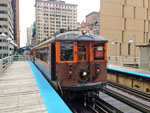
|
cta4271m.jpg (264k)
On April 14, 2013, the CTA's historic 4000-series cars, 4271-72, were moved from Linden Shop to Skokie Shop for storage, because Linden Shop was being reactivated for maintenance use for the duration of the Red Line South Reconstruction Project, whose closure of the Dan Ryan branch would cut off access to 98th Shop. The cars were taken from Linden to Skokie "the long way around" via the Loop, to give the cars, which do not operate often, a chance to stretch their legs and keep the components exercised and in good working order. The 2-car train led by car 4271 is at LaSalle/Van Buren on the Loop. (Photo by Mark Wolodarsky) |

- LaSalle-VanBuren.wav
(173k): "This is LaSalle and Van Buren. Transfer to Metra
trains at LaSalle and Van Buren."
(Sound courtesy of Tony Coppoletta)














